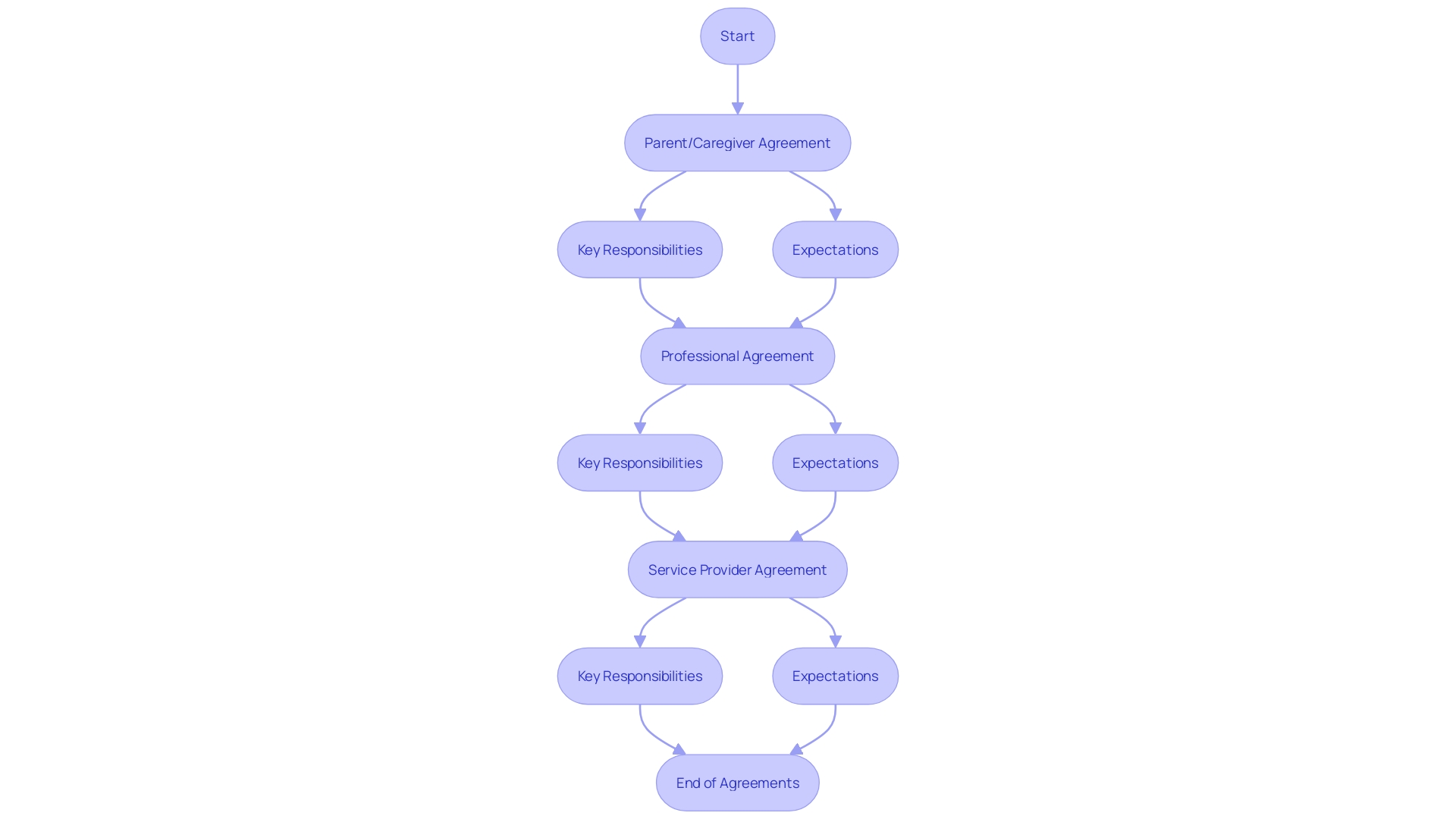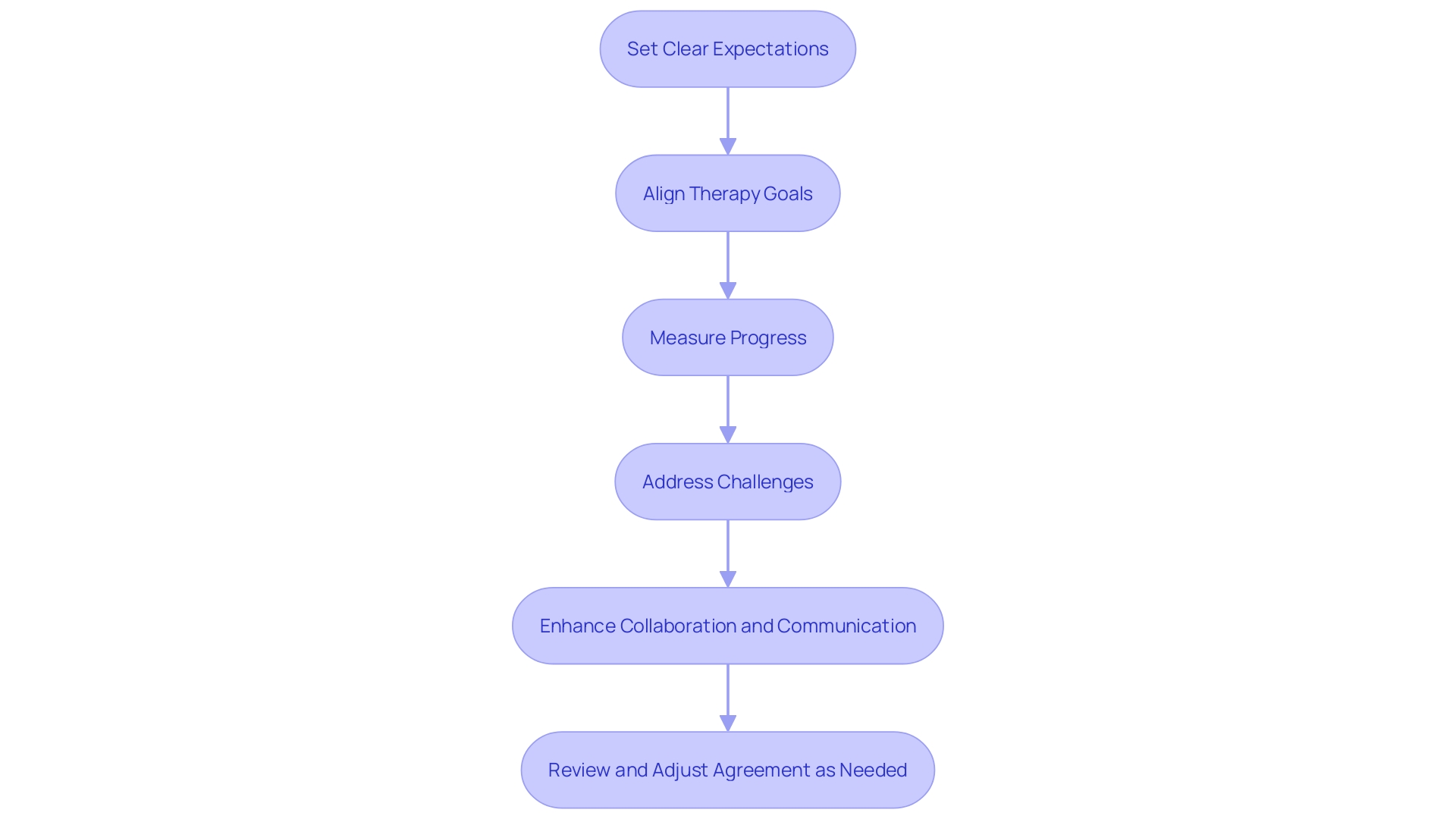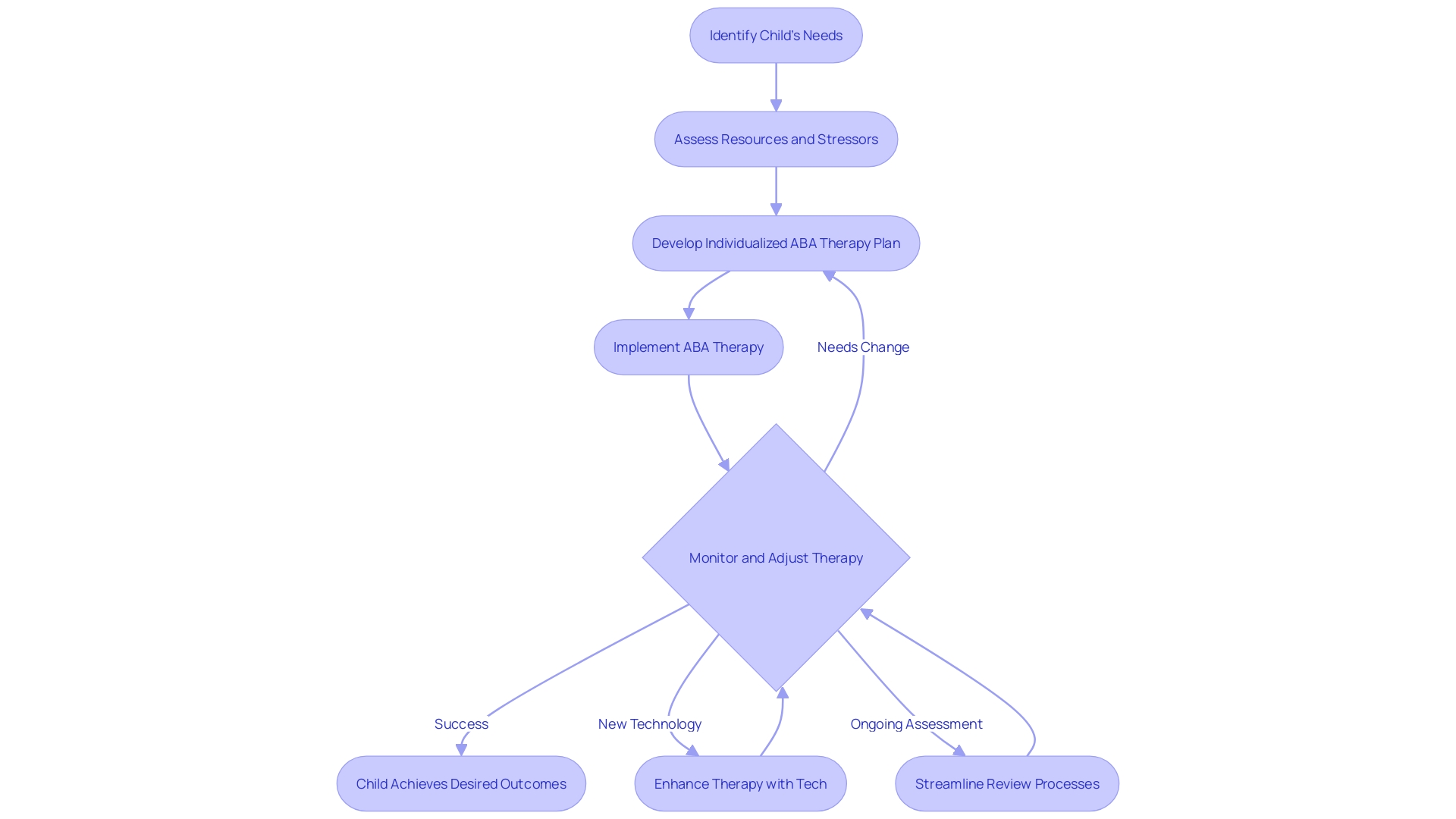Introduction
Applied Behavior Analysis (ABA) Therapy has revolutionized the support system for individuals with autism spectrum disorder (ASD) and related developmental disabilities. At the core of ABA lies a rigorous, evidence-based approach that meticulously assesses behavior and its environmental influences. The ultimate goal is to encourage positive behaviors and mitigate those that may be challenging, ultimately leading to improved social interactions and life skills.
Recent industry shifts reflect a changing landscape in ABA therapy. The integration of flexible, hybrid work models attracts skilled professionals by addressing their need for work-life balance. Moreover, the business aspect of ABA services has garnered attention from private equity firms, underscoring the growing recognition of ABA therapy's value and the potential for enhancing the delivery of autism services.
In this article, we will explore the crucial role of agreements in ABA Therapy. These agreements are not just formalities; they are the backbone of a successful therapeutic strategy. They foster a unified approach, outline responsibilities and objectives, and ensure high-quality, coordinated efforts among parents, professionals, and service providers.
We will delve into the different types of agreements in ABA therapy, the benefits they offer, and the challenges and considerations in crafting them. Additionally, we will examine best practices for implementing agreements and provide case studies that demonstrate their practical applications.
By understanding the importance of agreements in ABA therapy, we can create a supportive environment that empowers individuals with disabilities and ensures their well-being. Let's explore how these agreements can pave the way for effective, personalized care and positive outcomes for those on the autism spectrum.
What is ABA Therapy?
Applied Behavior Analysis (ABA) Therapy has revolutionized the support system for individuals with autism spectrum disorder (ASD) and related developmental disabilities. At the core of ABA lies a rigorous, evidence-based approach that meticulously assesses behavior and its environmental influences. The ultimate goal is to encourage positive behaviors and mitigate those that may be challenging, ultimately leading to improved social interactions and life skills.
Renowned for her extensive clinical expertise, a Board-Certified Behavior Analyst from New York has been instrumental in marrying ABA principles with cutting-edge technology. Her work, which spans over a decade, encompasses direct patient care, care management, and the development of technology solutions that facilitate coordinated, high-quality care. These solutions are pivotal in streamlining the review processes between healthcare providers and plans, ensuring that best practices are always at the forefront of patient care.
Recent industry shifts, as reported by the AT-Newswire Press Release News Distribution, reflect a changing landscape in ABA therapy. The integration of flexible, hybrid work models attracts skilled professionals by addressing their need for work-life balance. Such innovations are paramount in the quest for top talent within the ABA field, including Registered Behavior Technicians (RBTs) and Board-Certified Behavior Analysts (BCBAs).
Moreover, the business aspect of ABA services has garnered attention from private equity firms, as highlighted by executive insights and substantial investments in the sector. These developments underscore the growing recognition of ABA therapy's value and the potential for enhancing the delivery of autism services.
ABA Therapy remains a beacon of hope for many, and with the amalgamation of clinical know-how and technological advancements, it stands poised to offer even more effective, personalized care for those on the autism spectrum.
The Role of Agreements in ABA Therapy
Agreements in ABA Therapy are not just formalities; they are the backbone of a successful therapeutic strategy. These documents do more than outline the roles and expectations of parents, professionals, and service providers—they embody a mutual understanding and commitment to the goals and methodologies of treatment. By articulating responsibilities and objectives, agreements foster a unified approach that benefits the individual in therapy.
Consider the application of the social model of disability within these agreements: it reframes disability as a product of social constructs, emphasizing the importance of societal change over individual adaptation. This perspective is critical in shaping ABA practices that respect the identity and rights of autistic individuals. Furthermore, agreements must reflect a standard of care that is not only best practice but also ensures high quality and coordinated efforts, as identified by experts in the field.
Through these agreements, all parties involved in ABA Therapy can work cohesively towards enabling better behavioral and mental health outcomes, advocating for the rights and dignity of those with disabilities.
Types of Agreements in ABA Therapy
In Applied Behavior Analysis (ABA) therapy, agreements play a crucial role in establishing a collaborative framework for success. A Parent/Caregiver Agreement sets clear expectations, detailing the support needed from parents or caregivers. This could involve active participation in therapy sessions, applying learned strategies at home, and sharing valuable insights with the therapist to fine-tune the approach.
The Professional Agreement is another cornerstone of ABA therapy, delineating the ABA therapist's duties. These professionals are responsible for providing consistent therapy sessions, evaluating progress through assessments, and engaging with other specialists to ensure comprehensive care.
Lastly, the Service Provider Agreement offers a transparent outline of service terms, such as scheduling, fees, and any supplementary services. This agreement is essential for maintaining clarity about the therapy's financial and logistical elements, thus fostering trust and understanding between families and therapy providers.
Each of these agreements is instrumental in forging an environment of mutual respect and clear communication, which is particularly beneficial when coordinating care with experienced professionals like New York state-licensed and Board-Certified Behavior Analysts. These specialists often bring extensive clinical knowledge to the table, from direct patient care to the creation of technology solutions that streamline care coordination and review processes, ensuring that best practices and high-quality services are delivered.

Benefits of Agreements in ABA Therapy
In the realm of Applied Behavior Analysis (ABA) therapy, agreements serve as foundational tools that streamline the therapeutic process, foster mutual understanding, and boost collaborative efforts. For instance, they set clear expectations, allowing all parties involved—parents, therapists, and professionals—to understand their roles and responsibilities. This clarity is crucial in avoiding misunderstandings and ensuring that the therapy sessions are as effective as possible.
Secondly, agreements are instrumental in ensuring that the therapy goals of all stakeholders are in sync. When parents and professionals align on objectives, the therapy is more likely to produce the desired outcomes for the child. A unified direction in therapy is not just a matter of efficiency; it's about making real, tangible progress in the child's development.
Accountability is another cornerstone of effective ABA therapy, and agreements lay the groundwork for it. They act as benchmarks against which progress can be measured, and adherence to the therapy plan can be assessed. Should challenges or concerns arise, these agreements provide a structured way to address and resolve them, keeping the therapy on track.
Lastly, agreements enhance collaboration and communication among everyone involved. By formalizing the expectations and responsibilities, there's a clear framework for exchanging information and insights. This paves the way for joint decision-making and ensures that the therapy services are comprehensive and personalized to the child's needs.
These aspects are not just theoretical but are backed by professionals with years of clinical experience in ABA therapy. For example, a New York state-licensed and Board-Certified Behavior Analyst, with over a decade of experience, emphasizes the importance of using technology to streamline care coordination and review processes, which aligns with the effective implementation of agreements in ABA therapy. Furthermore, the recent federal rule urging child welfare agencies to develop standards for kinship caregivers, informed by research from the ABA Center on Children and the Law, echoes the sentiment that structured, clear guidelines and support systems lead to better outcomes for children, a principle that is at the heart of creating agreements in ABA therapy.

Challenges and Considerations
Crafting agreements in ABA Therapy is a nuanced process that requires a thoughtful approach tailored to each individual. The uniqueness of the therapy recipient must be at the forefront, with considerations for their age, developmental stage, and specific abilities. For instance, adjustments for co-occurring conditions are not just helpful; they are necessary to ensure that agreements are not only suitable but also actionable.
The dynamic nature of ABA Therapy means that flexibility is not optional—it's imperative. As individuals progress or face new challenges, therapy plans must evolve. This adaptability ensures that the therapy remains aligned with the individual's current needs, fostering an environment where positive outcomes can flourish.
Furthermore, the foundation of any successful therapy agreement lies in consistent communication and the willingness to update plans regularly. This requires all involved parties—parents, therapists, and other professionals—to engage in ongoing dialogue. Sharing insights and feedback transparently can lead to the fine-tuning of agreements, ultimately enhancing the quality of care and support provided.
A Board-Certified Behavior Analyst from New York, with over ten years of experience, underscores the importance of these considerations. Her expertise in crafting technology solutions that streamline care coordination and ensure high-quality outcomes for all stakeholders reflects the critical nature of personalized, flexible, and communicative approaches in ABA Therapy agreements.
Statistics from educational initiatives reinforce the importance of inclusion and individualized programming. With continued public awareness and legal support for the inclusion of children with disabilities, it becomes clear that ABA Therapy agreements must be designed with these values in mind, providing every child the opportunity to thrive in the most supportive environment possible.
Best Practices for Implementing Agreements
Maximizing the efficacy of ABA therapy hinges on the foundation of clear and mutually agreed-upon terms. A collaborative ethos is paramount, where parents, therapists, and other stakeholders actively participate in crafting agreements. Their collective insights and experiences contribute to a more rounded and effective plan.
Precision in language is crucial; agreements should be articulated in a manner that is both specific and comprehensible, avoiding any professional jargon that could lead to misunderstandings.
Periodic evaluations and updates to these agreements are equally important, adapting to the evolving needs and milestones of the individual in therapy. It ensures that the agreements stay relevant and reflective of the person's current therapy journey. Lastly, the meticulous documentation of these agreements, including any revisions, is a critical practice.
It provides an invaluable record that can be referenced by all involved, facilitating a transparent and consistent therapeutic process.
Case Studies and Examples
Diving into the practical applications of agreements in ABA Therapy, we find a wealth of insights from seasoned professionals like the New York state-licensed and Board-Certified Behavior Analyst with over ten years of experience. Her work has been pivotal in melding clinical expertise with technological innovation to support best practices and high-quality coordinated care. This integration is crucial for therapists and providers, ensuring streamlined processes that are sensitive to the individual needs of those with autism and developmental disabilities.
Recent developments, such as the U.S. Administration for Children and Families' new rule, underscore the importance of tailored care. This rule encourages child welfare agencies to adopt unique standards for kinship caregivers, building on research from the ABA Center on Children and the Law. Findings demonstrate that children in kinship care experience better mental health, stability, and educational outcomes, illustrating the profound impact of customized, agreement-based care strategies.
These case examples paint a vivid picture of how agreements in ABA Therapy are not just about formalities but are the bedrock of effective, individualized treatment plans. They allow for the flexible adaptation of therapy to suit the evolving needs of each child, ultimately leading to more successful and fulfilling outcomes.

References
In the realm of Applied Behavior Analysis (ABA) therapy, establishing clear agreements is fundamental in shaping a supportive environment for individuals with disabilities. These agreements are essential to ensure that the unique needs of each person are met with dignity and respect. By recognizing disability as a social construct, as outlined by the social model of disability, ABA therapy can move towards a more inclusive and equitable practice.
Recognizing disability as a minority identity and a product of social injustice, as suggested by researchers Baglieri et al. and Siebers, agreements in ABA therapy must be crafted to promote social justice and avoid perpetuating discrimination.
Through the lens of the social model, ABA professionals can reflect on their practices and develop agreements that consider the rights and identities of autistic individuals. This approach aligns with the civil rights perspective, which views disability discrimination as an issue of societal inequity. As echoed by the words of an authority on the matter, the commitment to uphold the rights of individuals with disabilities is not only a legal mandate but also a moral imperative to improve the lives of this community.
Bringing a wealth of clinical experience and expertise in behavior analysis, New York state-licensed and Board-Certified Behavior Analysts are leading the way in enhancing ABA therapy practices. With over a decade of experience in patient care and care management, these professionals are at the forefront of developing technology solutions that support best practices and high-quality, coordinated care. This commitment to excellence is evident in the significant improvements in streamlining care processes, ensuring that individuals receive the support they need in a manner that respects their autonomy and promotes their well-being.
Such advances in ABA therapy are echoed in recent policy changes, such as the U.S. Administration for Children and Families' rule urging child welfare agencies to develop standards for kinship caregivers. Research by the ABA Center on Children and the Law supports this kin-first approach, indicating that children in the care of family members experience better behavioral and mental health outcomes. This policy shift underscores the importance of agreements in ABA therapy that are culturally sensitive and centered on the individual's best interest.
In conclusion, the integration of the social model of disability into ABA therapy practices, backed by a wealth of clinical knowledge and technological innovation, represents a paradigm shift towards a more just and individual-centered approach. It is through these thoughtful and informed agreements that ABA therapy can contribute to building a society that values and respects the rights and identities of all individuals.
Conclusion
In conclusion, agreements in ABA Therapy are crucial for a successful therapeutic strategy. They foster collaboration, provide clarity in roles and responsibilities, and ensure high-quality, coordinated efforts among all parties involved. Different types of agreements, such as the Parent/Caregiver Agreement, the Professional Agreement, and the Service Provider Agreement, play a vital role in outlining expectations and promoting effective communication.
Crafting agreements in ABA Therapy requires careful consideration of the individual's uniqueness and ongoing flexibility. Best practices include a collaborative approach, precision in language, periodic evaluations, and thorough documentation.
Case studies and examples demonstrate the practical applications of agreements, highlighting their contribution to personalized treatment plans and positive outcomes.
Overall, agreements in ABA Therapy create a supportive environment that empowers individuals with disabilities and ensures their well-being. They are essential in promoting collaboration, providing clarity, and establishing a unified approach to therapy. By recognizing the importance of agreements, we can pave the way for effective, personalized care and positive outcomes for individuals on the autism spectrum.




